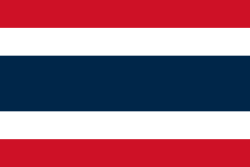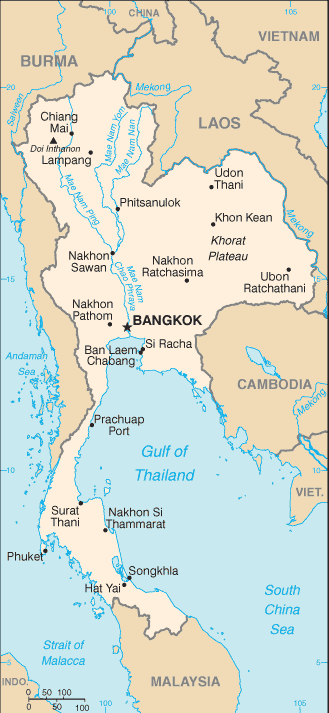Kingdom of Thailand
Related Categories:
 Flag of Thailand
Flag of ThailandFive horizontal bands of red (top), white, blue (double width), white, and red. |
 Thailand - Fotw
Thailand - FotwThe story goes that during the 1916 flood the king of Siam saw the national flag hanging upside down... Because of the distress a new flag was adopted that could not be hung upside down.
www.fotw.us/flags/th.html Thailand - wikipedia.org
The country's official name was Siam until June 24, 1939. The region known today as Thailand has been inhabited by human beings since the paleolithic period (about 500,000 - 10,000 years ago). Due to its geographical location, Thai culture has always been greatly influenced by India and China as well as the indigenous cultures of Southeast Asia.
en.wikipedia.org/
Thailand's population is relatively homogeneous. More than 85% speak a dialect of Thai and share a common culture. This core population includes the central Thai (33.7% of the population, including Bangkok), Northeastern Thai (34.2%), northern Thai (18.8%), and southern Thai (13.3%).
The language of the central Thai population is the language taught in schools and used in government. Several other small Thai-speaking groups include the Shan, Lue, and Phutai.
Up to 12% of Thai are of significant Chinese heritage, but the Sino-Thai community is the best integrated in Southeast Asia. Malay-speaking Muslims of the south comprise another significant minority group (2.3%). Other groups include the Khmer; the Mon, who are substantially assimilated with the Thai; and the Vietnamese. Smaller mountain-dwelling tribes, such as the Hmong and Mein, as well as the Karen, number about 788,024.
The population is mostly rural, concentrated in the rice-growing areas of the central, northeastern, and northern regions. However, as Thailand continues to industrialize, its urban population--31.6% of total population, principally in the Bangkok area--is growing.
Thailand's highly successful government-sponsored family planning program has resulted in a dramatic decline in population growth from 3.1% in 1960 to less than 1% today. Life expectancy also has risen, a positive reflection of Thailand's efforts at public health education. However, the AIDS epidemic has had a major impact on the Thai population. Today, over 600,000 Thais live with HIV or AIDS--approximately 1.5% of the adult population. Each year until at least 2006, 30-50,000 Thais will die from AIDS-related causes. Ninety percent of them will be aged 20-49, the most productive sector of the workforce. The situation could have been worse; an aggressive public education campaign in the early 1990s reduced the number of new HIV infections from over 100,000 annually.
The constitution mandates 12 years of free education, however, this is not provided universally. Education accounts for 16.6% of total government expenditures.
Theravada Buddhism is the official religion of Thailand and is the religion of about 95% of its people. The government permits religious diversity, and other major religions are represented. Spirit worship and animism are widely practiced.
www.state.gov/r/
Introduction
About
Contact
Symbols in The News
Interpret this Symbol
AAC
African
AI
Alchemy
Alphabets
Ancient
Animal Symbolism
Architecture
Art
Articles
Astrology
Baha'i
Blissymbolics
Blueprint Symbols
Buddhist
Celtic Symbols
Cemetery
Chinese Symbols
Christian
Circle
City
Codes
Color
Conlangs
Crop Circles
Danger
Da Vinci Code
Designing Logos
Dictionaries
Dreams
Education
Egyptian Symbols
Electrical
Emoticons
Find Images
Fonts
Food
Fraternity
Hamsa
Healing
Heraldry
Hermetic
Highway Signs
Hindu
History
Hobo
Holiday
Icons
iConji
Islamic
Jain Symbols
Japanese, Kanji
Jewish
Justice
Law
Literary Symbolism
Mandalas
Map
Masonic
Math, Number
Meaning of Names
Medical
Middle East
Military
Miscellaneous
Money
Music
Mythology
Native American
Playing Cards
Power
Psychology
QiQiiKhu
Reiki
Religious
Runes, Norse
Sacred Geometry
Scientific
Science Fiction
Sorority
Sports
Symbols in the News
Tattoos
ThirteenSymbols
Tree of Life
Ursprache
Videos
Visual Languages
Weather
Web Codes
Wicca
Words
Writing Systems
Braille
Coinherence
Coptic
Cuneiform
Easter Island
Etruscan
Happy Human
Hebrew
Kokopelli
Linear B
Lotus
Love Symbols
Mandorla
Moon Alphabet
Nine Pointed Star
Om
Oz
Phonetic
Scarab Beetle
Silent
Theosophy
Unifon
About
Contact
Symbols in The News
Interpret this Symbol
AAC
African
AI
Alchemy
Alphabets
Ancient
Animal Symbolism
Architecture
Art
Articles
Astrology
Baha'i
Blissymbolics
Blueprint Symbols
Buddhist
Celtic Symbols
Cemetery
Chinese Symbols
Christian
Circle
City
Codes
Color
Conlangs
Crop Circles
Danger
Da Vinci Code
Designing Logos
Dictionaries
Dreams
Education
Egyptian Symbols
Electrical
Emoticons
Find Images
Fonts
Food
Fraternity
Hamsa
Healing
Heraldry
Hermetic
Highway Signs
Hindu
History
Hobo
Holiday
Icons
iConji
Islamic
Jain Symbols
Japanese, Kanji
Jewish
Justice
Law
Literary Symbolism
Mandalas
Map
Masonic
Math, Number
Meaning of Names
Medical
Middle East
Military
Miscellaneous
Money
Music
Mythology
Native American
Playing Cards
Power
Psychology
QiQiiKhu
Reiki
Religious
Runes, Norse
Sacred Geometry
Scientific
Science Fiction
Sorority
Sports
Symbols in the News
Tattoos
ThirteenSymbols
Tree of Life
Ursprache
Videos
Visual Languages
Weather
Web Codes
Wicca
Words
Writing Systems
Braille
Coinherence
Coptic
Cuneiform
Easter Island
Etruscan
Happy Human
Hebrew
Kokopelli
Linear B
Lotus
Love Symbols
Mandorla
Moon Alphabet
Nine Pointed Star
Om
Oz
Phonetic
Scarab Beetle
Silent
Theosophy
Unifon
